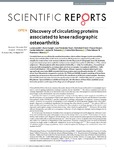Mostrar o rexistro simple do ítem
Discovery of circulating proteins associated to knee radiographic osteoarthritis
| dc.contributor.author | Lourido Salas, Lucía María | |
| dc.contributor.author | Ayoglu, Burcu | |
| dc.contributor.author | Fernández-Tajes, Juan | |
| dc.contributor.author | Oreiro, Natividad | |
| dc.contributor.author | Henjes, Frauke | |
| dc.contributor.author | Hellström, Cecilia | |
| dc.contributor.author | Schwenk, Jochen M. | |
| dc.contributor.author | Ruiz-Romero, Cristina | |
| dc.contributor.author | Nilsson, Peter | |
| dc.contributor.author | Blanco García, Francisco J | |
| dc.date.accessioned | 2020-03-24T10:41:11Z | |
| dc.date.available | 2020-03-24T10:41:11Z | |
| dc.date.issued | 2017-03-09 | |
| dc.identifier.citation | Lourido L, Ayoglu B, Fernández-Tajes J, Oreiro N, Henjes F, Hellström C, Schwenk JM, Ruiz-Romero C, Nilsson P, Blanco FJ. Discovery of circulating proteins associated to knee radiographic osteoarthritis. Sci Rep. 2017 Mar 9;7(1):137. | es_ES |
| dc.identifier.issn | 2045-2322 | |
| dc.identifier.uri | http://hdl.handle.net/2183/25229 | |
| dc.description.abstract | [Abstract] Currently there are no sufficiently sensitive biomarkers able to reflect changes in joint remodelling during osteoarthritis (OA). In this work, we took an affinity proteomic approach to profile serum samples for proteins that could serve as indicators for the diagnosis of radiographic knee OA. Antibody suspension bead arrays were applied to analyze serum samples from patients with OA (n = 273), control subjects (n = 76) and patients with rheumatoid arthritis (RA, n = 244). For verification, a focused bead array was built and applied to an independent set of serum samples from patients with OA (n = 188), control individuals (n = 83) and RA (n = 168) patients. A linear regression analysis adjusting for sex, age and body mass index (BMI) revealed that three proteins were significantly elevated (P < 0.05) in serum from OA patients compared to controls: C3, ITIH1 and S100A6. A panel consisting of these three proteins had an area under the curve of 0.82 for the classification of OA and control samples. Moreover, C3 and ITIH1 levels were also found to be significantly elevated (P < 0.05) in OA patients compared to RA patients. Upon validation in additional study sets, the alterations of these three candidate serum biomarker proteins could support the diagnosis of radiographic knee OA. | es_ES |
| dc.description.sponsorship | info:eu-repo/grantAgreement/MINECO/Programa Estatal de I+D+I Orientada a los Retos de la Sociedad/PI16%2F02124/ES/Determinación de índices predictivos de diagnóstico y pronóstico de artrosis de rodilla mediante la validación de biomarcadores proteicos | es_ES |
| dc.description.sponsorship | info:eu-repo/grantAgreement/MINECO/Programa Estatal de I+D+I Orientada a los Retos de la Sociedad/PI14%2F01707/ES/Validación de biomarcadores proteicos de artrosis mediante proteómica dirigida para el desarrollo de un método de diagnóstico in vitro | es_ES |
| dc.description.sponsorship | info:eu-repo/grantAgreement/MINECO/Acción Estratégica de Salud/PI12%2F00329/ES/PROYECTO PROTEOMA HUMANO ESPAÑOL: Aplicacion en Enfermedades Reumatologicas | es_ES |
| dc.description.sponsorship | Instituto de Salud Carlos III; CIBER-CB06/01/0040 | es_ES |
| dc.description.sponsorship | info:eu-repo/grantAgreement/MINECO/Acción Estratégica de Salud/RD12%2F0009%2F0018/ES/Inflamación y enfermedades reumáticas | es_ES |
| dc.language.iso | eng | es_ES |
| dc.publisher | Nature | es_ES |
| dc.relation.uri | https://doi.org/10.1038/s41598-017-00195-8 | es_ES |
| dc.rights | Creative Commons Attribution 4.0 International License (CC-BY 4.0) | es_ES |
| dc.rights.uri | http://creativecommons.org/licenses/by/4.0/ | * |
| dc.subject | Osteoarthritis | es_ES |
| dc.subject | Proteomics | es_ES |
| dc.subject | Sensitivity and Specificity | es_ES |
| dc.subject | Biomakers | es_ES |
| dc.subject | Knee | |
| dc.title | Discovery of circulating proteins associated to knee radiographic osteoarthritis | es_ES |
| dc.type | journal article | es_ES |
| dc.rights.accessRights | open access | es_ES |
| UDC.journalTitle | Scientific Reports | es_ES |
| UDC.volume | 7 | es_ES |
| UDC.issue | 1 | es_ES |
| UDC.startPage | 137 | es_ES |
| UDC.coleccion | Investigación | es_ES |
| UDC.departamento | Fisioterapia, Medicina e Ciencias Biomédicas | es_ES |
| UDC.grupoInv | Reumatoloxía (INIBIC) | es_ES |
| UDC.grupoInv | Grupo de Investigación en Reumatoloxía e Saúde (GIR-S) | es_ES |
| UDC.institutoCentro | INIBIC - Instituto de Investigacións Biomédicas de A Coruña | es_ES |
| dc.relation.projectID | info:eu-repo/grantAgreement/EC/FP7/305549 | es_ES |
Ficheiros no ítem
Este ítem aparece na(s) seguinte(s) colección(s)
-
Investigación (FCS) [1293]






